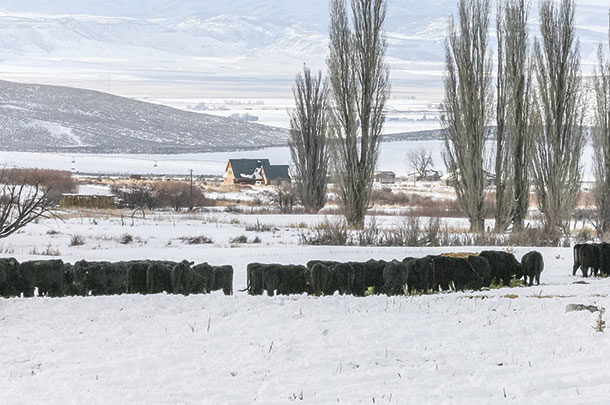No matter how this group is fed, the importance of a watchful eye on their proper hydration as they complete this transition cannot be minimized. It is not simply enough to let them fend for themselves through the winter months.
Dr. Megan Van Emon, extension beef cattle specialist at Montana State University, emphasizes that water is the most essential nutrient for livestock production. “It is needed for numerous processes, such as the regulation of body temperature, growth, digestion, reproduction, metabolism, lubrication of joints, excretion, eyesight, etc. Water is also an excellent solvent for amino acids, minerals, glucose, vitamins and metabolic waste.”
While a mature cow can consume between 20 and 40 gallons of water per day during the hottest months of the year, even in cooler winter temperatures, they still require roughly half of that amount. Although some of the cow’s fluid needs are supplied in the feed they consume, between 60%-80% of their required intake comes in the form of water.
The rumen acts as a liquid reservoir by which the body’s fluid balance can be maintained over short periods of time, but if circumstances challenge the hydration status of a beef cow, she will attempt to replenish this balance through drinking. If this fails, she will begin to use up her bodily reserves to maintain homeostasis, eventually leading to clinical hydration and even death.
But some producers are not equipped to supply water through conventional methods such as electric bowls, wells and troughs to all areas of their winter grazing and holding grounds. Bred cows and heifers can survive on winter snow, but is it a reasonable way to hydrate the herd?
Jim Keyes, Utah State University extension area animal scientist says, “Many wonder if cows can eat snow in the winter to supply all their water needs. The answer is, yes. Just turning cattle loose on the snow sounds like a very simple management technique, but it requires that ranchers pay very close attention to the animal’s body condition and general health.”
Keyes stresses that there are exceptions and qualifications to his answer. He explains that cows should have at least a body condition score of 4 to depend only on snow for their water needs. Thinner animals should always have access to a water source. He encourages producers to create a plan B if weather conditions do not cooperate and there is a lack of snow. Snow must also be clean and accessible, meaning cows need access to a large enough area for this to be possible. “Ice-crusted, wind-blown or trampled snow is not adequate,” he says. “Make certain feed intake does not decline. A mature cow will eat 2.5% of her bodyweight each day. A reduction in feed intake may mean insufficient water intake.”
Dr. Roy Lewis, DVM, Westlock, Alberta, agrees with the positives of snow usage. “There are many benefits to eating snow as it relates to management and costs on your farm. Stockpiled pastures or remote and protected wintering areas can be utilized. You save electricity costs by not heating watering bowls and running pumping systems.” Beyond this, he goes on to describe the cost savings of trenching in water lines, building infrastructure or purchasing all-weather watering systems. He adds that by moving the feeding area, the manure is spread out considerably, eliminating the need for its removal. Calving yards can also be kept clean until needed.
Research trials in Montana and Alberta have evaluated the effects of snow as a water source. In one experiment, a group of pregnant beef cows were provided only snow while a similar group were given access to heated water. The cows eating only snow consumed between 30 and 40 pounds each day to meet their needs. The group with access to water drank only 2 to 3 gallons per day, but also ate up to 25 pounds of snow. A separate trial showed that when provided access to both water and snow, only 65% of cows drank water every day, with the remainder only drinking occasionally and 2% never drinking water. No visible differences in condition and appearance were seen.
Although most dehydration cases can be treated and often reversed, the reliable way to avoid them is to attack the causes through a focus on prevention. The first choice would always be providing actual water, but whether only snow or a combination of the two are used, there are considerations to address which will allow bred females the best chance at healthy success.
Sickness and disease must be proactively challenged. Implementation of veterinarian- approved vaccination processes for the adult heifer and cow herd is important. Allowing the suppression of the pregnant female’s immune system will quickly promote the degree of dehydration that is uncorrectable without assistance.
The challenge of aggressive or “bully” cows must be deterred. In open pasture or forage grazing near rivers, streams, ponds or bodies of water, the ability of such cows to be a hydration hazard to shy animals will be minimal, but in dry lot conditions, water troughs or automatic bowls should be plentiful and provide numerous “wet” areas with plenty of access to accommodate timid animals.
When introducing new cattle, environmental changes, transportation issues or other variations in routine should be anticipated and addressed and animal behavior and attitudes closely monitored to recognize fluid losses such as diarrhea and suspect stool conditions. Free-choice salt and minerals should be offered at all times.
A focused and organized management system that includes a veterinarian-guided herd health plan combined with close monitoring of animal behavior and the elimination of bully cow challenges is essential. A year-round water supply or Mother Nature providing enough clean snow to support herd numbers can deliver positive results while avoiding winter dehydration. ![]()
PHOTO: Winter requires ranchers to keep a watchful eye on their herds for access to waterers and if snow is plentiful enough for grazing cattle. Photo by Paul Marchant.
Bruce Derksen is a freelance writer based in Lacombe, Alberta. Email Bruce Derksen.











